Are you looking to enhance the beauty and diversity of your freshwater aquarium? Look no further than Ludwigia Peruensis, also known as Ludwigia Gladulosa.
This exquisite aquatic plant species is sure to captivate you with its vibrant colors and unique foliage.
Whether you’re an experienced aquarium enthusiast or just starting out, Ludwigia Peruensis is a must-have for any aquatic garden.
In this comprehensive guide, we will delve into the history, characteristics, benefits, care tips, propagation techniques, and more for Ludwigia Peruensis.
By the end of this article, you’ll have all the knowledge you need to incorporate this stunning aquatic plant into your aquarium successfully.
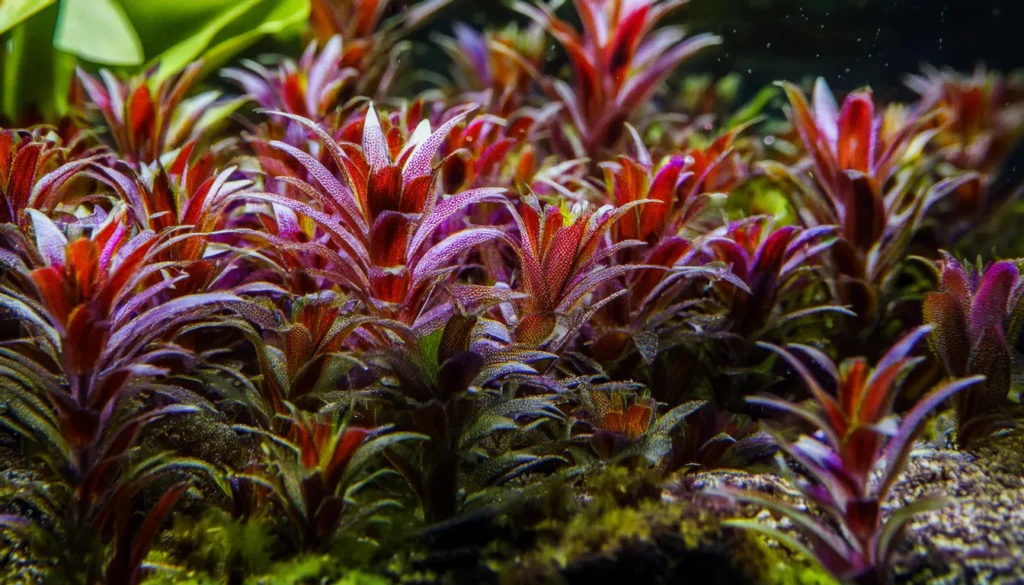
Key Takeaway
- Ludwigia Peruensis, also known as Ludwigia Gladulosa, is a vibrant and unique aquatic plant species.
- It adds beauty, diversity, and visual appeal to freshwater aquariums.
- Ludwigia Peruensis has spade-shaped leaves ranging from dark green to brownish red.
- Proper care and attention to lighting, nutrition, CO2 supplementation, and water conditions are essential for its healthy growth.
- Pairing Ludwigia Peruensis with complementary plants can enhance the overall aesthetics of your aquatic garden.
Quick Stats
| Attribute | Details |
| Family Name | Onagraceae |
| Origin | South America |
| Height | 20-50 cm (8-20 inches) |
| pH Range | 5.0 – 7.0 |
| CO2 Requirement | Moderate to High |
| Growth Rate | Moderate |
| Care Level | Moderate |
| Color Form | Leaves range from deep green to dark red/purple |
| Water Conditions | 22-28°C (72-82°F), soft to moderately hard water |
| Max Size | Can grow up to 50 cm (20 inches) tall |
| Lighting | High |
| Supplements | CO2 supplementation, iron, and other micronutrients are crucial for achieving vibrant colors |
| Placement | Mid-ground to Background |
| Propagation | Stem cuttings |
What Is Ludwigia Peruensis/Gladulosa?
Ludwigia Peruensis, also known as Ludwigia Gladulosa, is an aquatic plant in the family Onagraceae.
It is native to Europe and is widely recognized for its striking appearance and ease of maintenance.
The plant features spade-shaped leaves ranging from dark green to brownish red. Its vibrant hues create a visually appealing focal point in any aquatic garden.
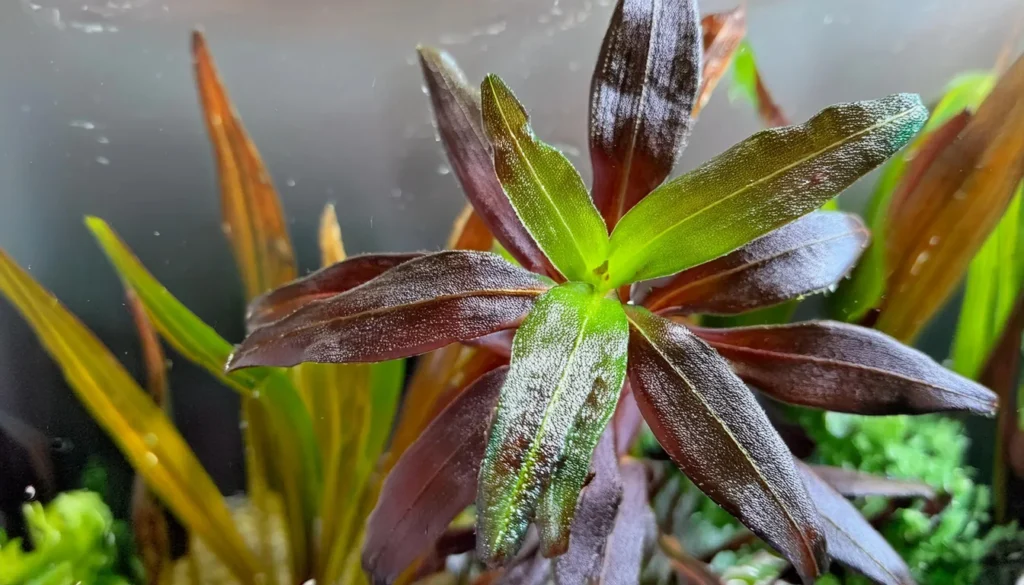
History
Ludwigia Peruensis, originally native to Europe, has a rich history in aquatic plants.
It has been cultivated and appreciated by aquarium enthusiasts for many years.
The plant’s journey into the aquarium hobby can be traced back to the early 20th century when it first gained popularity due to its unique visual appeal and adaptability to different aquatic environments.
Over time, Ludwigia Peruensis, also known as Ludwigia Gladulosa, has become a sought-after plant species for its ability to enhance the aesthetics of freshwater aquariums.
Its vibrant colors and striking foliage have captivated aquarium enthusiasts worldwide, making it a popular choice for aquascaping and adding a touch of natural beauty to aquariums of all sizes.
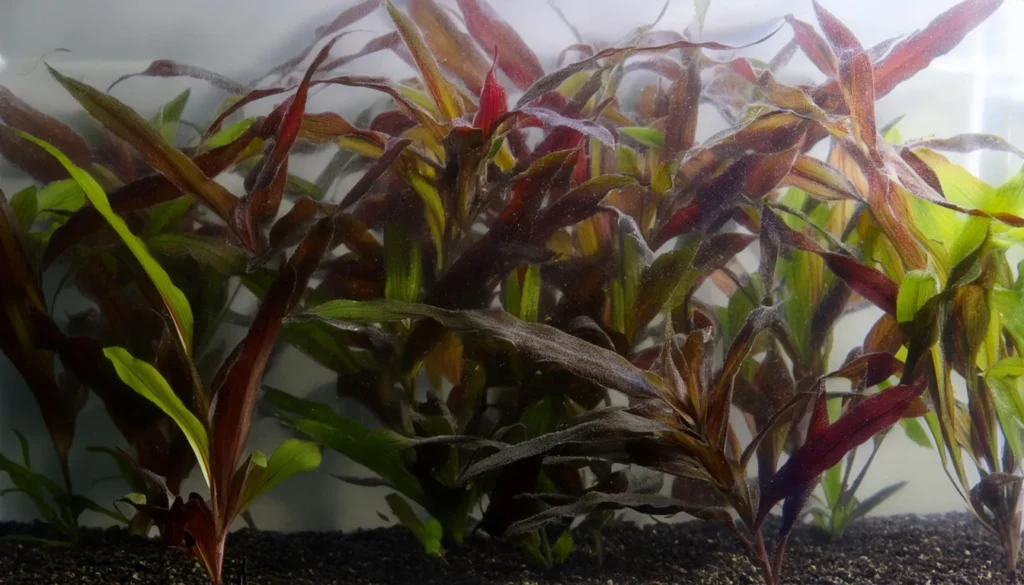
As Ludwigia Peruensis became more widely available, its popularity grew further.
Aquarium hobbyists recognized its ability to bring a touch of the natural world into their homes, creating stunning underwater landscapes reminiscent of lush aquatic ecosystems.
Today, Ludwigia Peruensis remains a favorite among aquarium enthusiasts, standing as a testament to the enduring appeal of aquatic plants in aquascaping and aquarium keeping.
Characteristics Of Ludwigia Peruensis
- Ludwigia Peruensis is a distinctive aquatic plant with unique characteristics that make it stand out among other aquarium plants. Its spade-shaped leaves grow in opposite pairs along the stem, creating an attractive arrangement.
- The color of the leaves can range from a deep green to a rich brownish red, depending on the aquarium’s lighting conditions and nutrient levels.
- This Ludwigia species has a moderate growth rate and can reach a height of 6-8 inches, making it suitable for medium-sized aquariums. It thrives in high light conditions, so providing ample lighting is essential to promote its growth and maintain its vibrant coloration.
- Ludwigia Peruensis is best suited for aquariums with a pH range of 6.5-7.5, creating an optimal environment for its health and development.
- Overall, Ludwigia Peruensis is a beautiful and versatile plant that adds visual interest and dimension to any aquatic garden.
Addressing Water Hardness And Temperature
- Water hardness, measured in terms of carbonate hardness (KH) and general hardness (GH), can impact the growth of Ludwigia Peruensis. This plant generally thrives in moderately to slightly soft water conditions. If necessary, appropriate water conditioners or additives can be used to adjust the water hardness.
- Furthermore, it is essential to maintain the water temperature within a suitable range for both the plant and the aquarium inhabitants. Consider the temperature requirements of the fish and invertebrates coexisting with Ludwigia Peruensis and ensure that the water temperature remains within their preferred range.

Optimal Lighting Conditions
- To ensure the healthy development of Ludwigia Peruensis, the right lighting conditions are essential. This plant thrives in high-light environments, so it is important to place it in a well-lit area of the aquarium.
- We recommend using full-spectrum LED lights or fluorescent lights to create the ideal lighting conditions for Ludwigia Peruensis. These types of lights provide the necessary intensity and spectrum for optimal photosynthesis and growth.
Temperature Parameters For Robust Growth
The optimal temperature range for robust growth of Ludwigia inclinata is typically between 22°C to 28°C (72°F to 82°F).
Within this range, the plant exhibits vigorous growth, vibrant coloration, and overall healthy foliage. Maintaining stable water temperatures within this range is crucial to promoting optimal growth and ensuring the plant’s well-being in the aquarium.
Substrate Requirement
- Nutrient-Rich Substrate: Provide a substrate rich in nutrients to support the plant’s root development and overall growth. Choose substrates specifically formulated for planted aquariums, or supplement with root tabs to ensure adequate nutrient availability.
- Grain Size: The substrate should have a medium grain size that allows for proper root anchorage while also facilitating nutrient absorption. Avoid substrates with excessively large grains that may hinder root penetration or compact too tightly, restricting nutrient flow.
- Depth: Aim for a substrate depth of at least 2 to 3 inches (5 to 7.5 centimeters) to accommodate Ludwigia inclinata’s root system. A deeper substrate provides ample space for root growth and promotes stability for the plants.
- CO2 Substrate: If you’re supplementing carbon dioxide (CO2) in your aquarium, consider using a CO2-enriched substrate or substrate additives. These can help maximize CO2 availability to the plant roots, enhancing growth and vitality.
Placement Option
- Background Planting: Ludwigia inclinata can be placed in the background of your aquarium to create a lush, dense backdrop. Plant taller stems toward the rear of the tank to add height and depth to the aquascape. This placement also helps conceal equipment and creates a natural-looking transition from the midground to the background.
- Midground Planting: Depending on the height of your aquarium, Ludwigia inclinata can also be used as a midground plant. Plant it in the middle or slightly towards the back of the tank to add texture and color to the midsection of the aquascape. This placement allows for easy maintenance and provides a visually appealing focal point.
- Group Planting: Plant Ludwigia inclinata in groups or clusters to create a more impactful visual effect. Grouping several stems together can accentuate the plant’s coloration and create a striking contrast against other plants or hardscape elements in the aquarium.
- Foreground Planting (in Larger Tanks): In larger aquariums, Ludwigia inclinata can be used as a foreground plant if trimmed regularly to maintain a compact growth habit. Plant it in the front corners or along the sides of the tank to frame the aquascape and add interest to the foreground area.
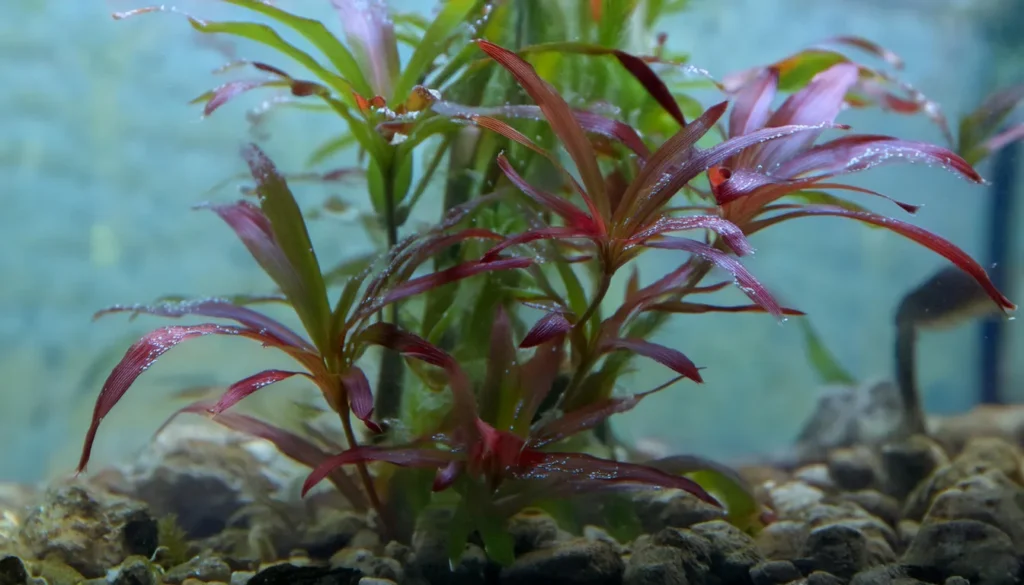
Recommended Tank Size
- Size Considerations: Ludwigia inclinata generally thrives in aquariums with a capacity of 10 gallons (38 liters) or larger. Larger tanks provide ample space for the plant to grow and spread its foliage, contributing to a visually appealing aquascape.
- Space for Growth: The recommended tank size ensures sufficient space for Ludwigia inclinata to establish its root system and develop lush foliage. In smaller tanks, overcrowding may occur, leading to competition for resources and inhibited growth.
- Aquatic Environment Stability: Larger tanks offer greater stability in water parameters such as temperature, pH, and hardness. This stability is essential for maintaining optimal conditions for Ludwigia inclinata’s growth and overall well-being.
- Aquascape Flexibility: With a tank size of 10 gallons or larger, aquarists have more flexibility in designing diverse aquascapes. Ludwigia inclinata can be positioned as a background, midground, or even foreground plant, depending on the tank’s dimensions and layout.
Complementary Plants For Ludwigia Aquascapes
- Anubias: Known for its broad, dark-green leaves, Anubias pairs well with Ludwigia Peruensis. Its slow growth and low light requirements make it ideal for creating a balanced and harmonious aquascape.
- Java Fern: With its textured fronds and contrasting leaf shape, Java Fern can add depth and visual interest to your aquascape. It is a hardy plant that can tolerate a wide range of water parameters.
- Cryptocoryne: Cryptocoryne plants come in various leaf shapes, sizes, and colors, making them versatile companions for Ludwigia Peruensis. They are known for their adaptability and can thrive in a range of lighting conditions.
Nutrient Requirements And Fertilization
- Ludwigia Peruensis has specific nutrient requirements for proper growth. These include carbon dioxide, nitrogen, phosphorus, and potassium.
- One way to ensure these nutrients are available to the plant is through liquid fertilizers or root tabs. These products contain the elements in a balanced formulation, providing the plant with the nutrients it needs to thrive.
- Regular water testing and monitoring are crucial to understanding the nutrient levels in the aquarium. This allows you to adjust the fertilization routine accordingly and ensure that Ludwigia Peruensis receives the proper nourishment for healthy growth.
Ludwigia Peruensis Cultivation Tips
- Nutrient Availability: Ludwigia peruensis is a nutrient-hungry plant. Supplement the aquarium with a comprehensive liquid fertilizer or root tabs to ensure adequate nutrient availability. Pay attention to dosing instructions to prevent nutrient deficiencies or excesses.
- CO2 Supplementation: Consider supplementing carbon dioxide (CO2) if possible. CO2 injection can enhance the growth and coloration of Ludwigia peruensis, promoting lush foliage and intensifying its red hues. However, the plant can still thrive in tanks without CO2 supplementation.
- Pruning and Maintenance: Regularly trim and prune the stems to encourage bushy growth and prevent overcrowding. Remove any dead or decaying plant material to maintain water quality and prevent nutrient imbalances. Additionally, remove any side shoots to encourage vertical growth.
- Propagation: Ludwigia peruensis can be propagated by stem cuttings. Simply trim healthy stems and replant them in the substrate. Ensure that each cutting has several nodes to promote root development. Regular pruning also stimulates new growth and helps maintain the plant’s shape.
- Water Flow: Provide moderate water flow to ensure nutrient distribution and prevent debris buildup on the plant’s foliage. Adequate water circulation is essential for delivering nutrients and CO2 to the plants while preventing algae growth.

Plant Propagation Tips
- Select Healthy Stems: Choose stems that are healthy, free from damage, and exhibit vibrant coloration. Avoid stems that show signs of disease, decay, or pest infestation.
- Prepare Stem Cuttings: Use sharp, clean scissors or aquascaping tools to trim stem cuttings from the parent plant. Cut the stems at a 45-degree angle to maximize the surface area for rooting. Each cutting should be approximately 3 to 6 inches (7.5 to 15 centimeters) in length, with at least two leaf nodes.
- Remove Lower Leaves: Strip away the lower leaves from each stem cutting, leaving only a few leaves near the tip. This reduces the demand for nutrients and helps prevent rotting when the stems are planted in the substrate.
- Planting Stem Cuttings: Plant the prepared stem cuttings directly into the substrate of the aquarium. Insert each cutting into the substrate, burying the lower portion of the stem while leaving the upper portion and remaining leaves exposed. Space the cuttings a few inches apart to prevent overcrowding.
Benefits Of Planting Ludwigia Peruensis
- Vibrant Coloration: Ludwigia peruensis is prized for its striking red and orange hues, which add a vibrant pop of color to your aquascape. The intense colors create visual interest and enhance the overall beauty of the aquarium.
- Aquascape Contrast: The bold coloration of Ludwigia peruensis creates contrast against green plants and hardscape elements, adding depth and dimension to your aquascape. This contrast helps create visually appealing focal points within the aquarium.
- Oxygenation: Like all aquatic plants, Ludwigia peruensis contributes to oxygenation in the aquarium through photosynthesis. During daylight hours, the plant absorbs carbon dioxide and releases oxygen, improving water quality and supporting fish and other aquatic life.
- Natural Filtration: Aquatic plants, including Ludwigia peruensis, help naturally filter the water by absorbing nutrients such as nitrates and phosphates. By assimilating these nutrients, the plant helps reduce algae growth and maintain water clarity.
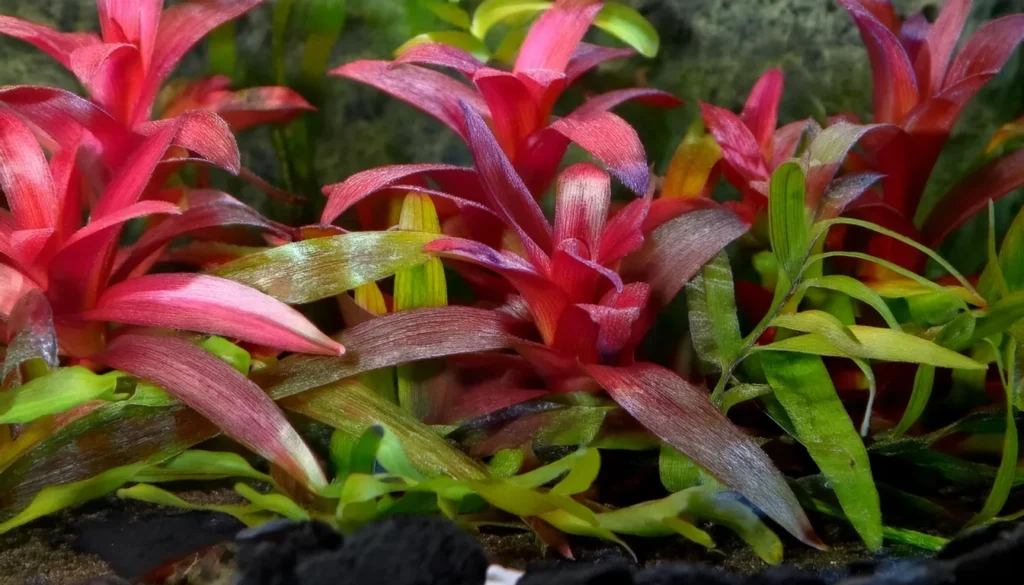
Understanding The Benefits Of CO2 Injection
- Promoting photosynthesis: CO2 is a crucial component for photosynthesis, the process by which plants convert light energy into chemical energy. By injecting CO2 into the aquarium, you can enhance the efficiency of photosynthesis in Ludwigia Peruensis, leading to faster growth and healthier foliage.
- Supporting nutrient absorption: Adequate CO2 levels help the plant absorb nutrients more effectively. This ensures that Ludwigia Peruensis receives the necessary nutrients for vibrant leaf growth and overall health.
- Preventing algae growth: CO2 injection suppresses algae growth in the aquarium. By providing ample CO2 to Ludwigia Peruensis, you can create an environment that discourages algae infestation, allowing the plant to thrive and maintain its vibrant colors.
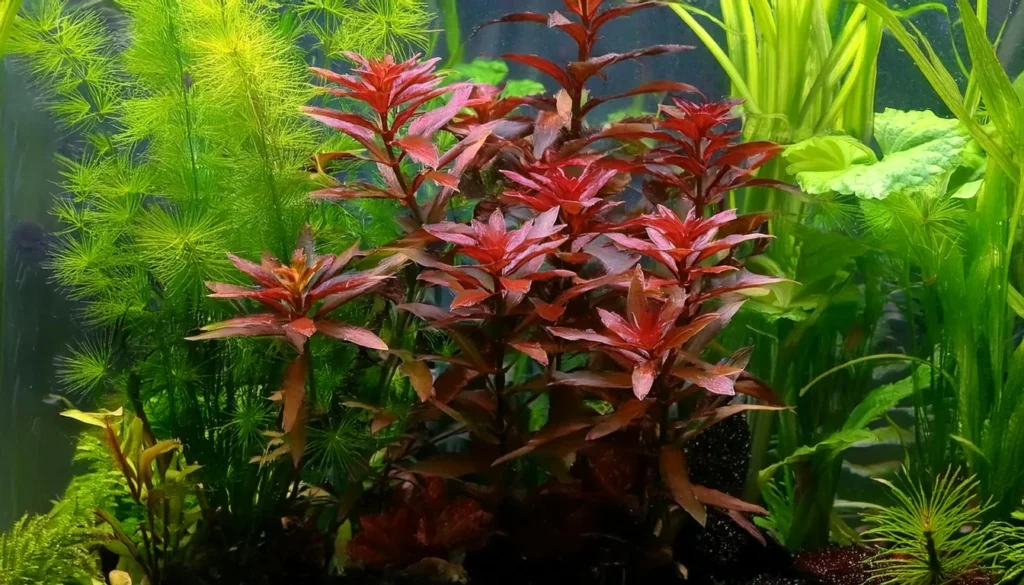
Avoiding And Managing Plant Melt And Rot
- Ensure consistent water parameters: Ludwigia Peruensis thrives in specific water conditions. Regularly test and regulate the temperature and pH levels of the aquarium.
- Provide proper nutrition: Adequate nutrient levels are essential for the health of Ludwigia Peruensis. Use a balanced liquid fertilizer or root tabs to supply essential nutrients.
- Avoid sudden changes: Gradually introduce any changes in water conditions to prevent stress on the plant. Sudden shifts can lead to plant melt and rot.
- Remove affected leaves: If plant melt or rot does occur, promptly remove affected leaves to prevent the spread of decay or toxins. Prune the plant to encourage new growth.
Conclusion
Ludwigia Peruensis, also known as Ludwigia Gladulosa, is an exquisite aquatic plant species that can add beauty, diversity, and vibrant colors to any aquatic garden.
With proper care and attention to lighting, nutrition, CO2 supplementation, and water conditions, this captivating plant can reach its full potential and become a visually striking focal point in your aquarium.
Whether you are an experienced aquarium enthusiast or a beginner, Ludwigia Peruensis is a wonderful choice for enhancing the aesthetic appeal of your aquatic garden.
Its spade-shaped leaves, ranging from dark green to brownish red, create a captivating visual display. By pairing Ludwigia Peruensis with complementary plants such as Anubias, Java Fern, or Cryptocoryne, you can create a balanced and visually appealing aquascape design that will impress you and your guests.
Proper care is essential for the healthy growth of Ludwigia Peruensis. Providing optimal lighting conditions, nutrient requirements, and CO2 levels will ensure the plant thrives in your aquarium.
Regular monitoring of pH levels, water hardness, and temperature is crucial to creating an environment supporting plant growth and vitality.
By following these care guidelines, you can enjoy the stunning beauty and diversity that Ludwigia Peruensis brings to your aquatic garden.
Frequently Asked Questions
What Are The Varieties And Cultivars Of Ludwigia Peruensis?
Ludwigia Peruensis has several variations and cultivars, including the Diamond Ludwigia, which features green leaves on top and red leaves underneath.
Different cultivars can exhibit variations in leaf shape, color, and size.
What Is The Role Of Co2 In Cultivating Ludwigia Peruensis?
CO2 supplementation enhances photosynthesis and promotes healthy leaf growth in Ludwigia Peruensis.
Adequate CO2 levels result in vibrant leaf colors. CO2 can be provided through injection systems or liquid carbon supplements.
How Do I Manage Water Conditions For Ludwigia Peruensis?
Monitor pH levels, address water hardness, and maintain suitable water temperature for Ludwigia Peruensis.
It thrives in slightly soft water conditions with a pH range of 6.5-7.5.
How Can I Design My Aquatic Garden With Ludwigia Peruensis?
Use Ludwigia Peruensis as a focal point and pair it with complementary plants.
Vary the height and placement of different plants to create visually striking aquascapes.
What Are Common Challenges And Solutions In Ludwigia Peruensis Care?
Common challenges include plant melt and rot due to sudden changes in water conditions.
To prevent these issues, maintain stable water conditions and carefully handle fragile Ludwigia stems.
- Unveiling The Wonders Of Riccia Fluitans In Aquascapes - August 7, 2024
- Vallisneria Gigantea Var. Guide To Care And Cultivation At Home - July 31, 2024
- Vesicularia Dubyana Care & Growth Guide Tips For Beginner Gardeners - July 30, 2024
